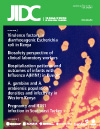Skin biopsy: a pillar in the identification of cutaneous Mycobacterium tuberculosis infection
DOI:
https://doi.org/10.3855/jidc.2729Keywords:
cutaneous tuberculosis, polymerase chain reaction (PCR), Mycobacterium tuberculosisAbstract
Introduction: The present study aimed to establish the frequency and clinical characteristics of cutaneous tuberculosis among Mexican adult patients.
Methodology: Ninety-five patients with clinically compatible lesions to cutaneous tuberculosis participated in the study. All patients were HIV negative and none of them had previous anti-TB treatment. A skin biopsy was taken from every patient suspected of having tuberculosis, and a histopathologic examination was performed as follows: Ziehl-Neelsen staining; culturing of mycobacteria by Löwenstein-Jensen (L-J) medium; Mycobacteria Growth Indicator Tube detection via BACTEC (MGIT-360); and polymerase chain reaction (PCR) with the sequence of insertion IS6110 for Mycobacterium tuberculosis complex.
Results: Tuberculosis was confirmed in 65 out of 95cases (68.4%). Identified lesions were scrofuloderma (42 cases, 64.6%); lupus vulgaris (12 cases, 18.4%); warty tuberculosis (six cases, 9.2%); and papulonecrotic tuberculoid (five cases; 7.7%). The Ziehl-Neelsen staining was positive for acid fast bacilli in nine cases (13.8%) and 48 patients were positive for the PCR amplification (73.8%). All skin biopsies resulted positive for tuberculosis. A positive clinical response to the specific treatment was considered a confirmation for tuberculosis. The noninfectious etiology corresponded to 30 cases (31.6%).
Conclusions: Tuberculosis in developing countries is still an important cause of skin lesions which must be studied via histopathological examination and culture due to their low bacillary load. A PCR test is necessary to obtain faster confirmation of the disease and to establish an early, specific and effective treatment.
Downloads
Published
How to Cite
Issue
Section
License
Authors who publish with this journal agree to the following terms:
- Authors retain copyright and grant the journal right of first publication with the work simultaneously licensed under a Creative Commons Attribution License that allows others to share the work with an acknowledgement of the work's authorship and initial publication in this journal.
- Authors are able to enter into separate, additional contractual arrangements for the non-exclusive distribution of the journal's published version of the work (e.g., post it to an institutional repository or publish it in a book), with an acknowledgement of its initial publication in this journal.
- Authors are permitted and encouraged to post their work online (e.g., in institutional repositories or on their website) prior to and during the submission process, as it can lead to productive exchanges, as well as earlier and greater citation of published work (See The Effect of Open Access).








